-
Countries
-
Data and Analysis
-
Special Focus
-
Crisis Responses
Assessment Report

Contact
DTMUkraine@iom.int
Language
English
Location
Ukraine
Period Covered
Oct 23 2023
Oct 31 2023
Activity
- Mobility Tracking
This report serves to identify the heating systems employed in Ukrainian households, presents the estimated prices of solid fuel items across different oblasts, and examines the methods and frequency of solid fuel collection by the Ukrainian population. The report investigates the current and future demand, supply, and prices of essential solid fuel products. The overarching objective is to support ongoing humanitarian winterization operations.
Between 23 and 31 October 2023, the Data and Analytics (D&A) team surveyed 314 markets in 23 oblasts and Kyiv City in Ukraine, conducting face-to-face and remote interviews with both local vendors and community focal points (CFPs). In each oblast, data was collected in at least two locations, one urban and one rural and/or near frontline locations, where applicable. In each location, a minimum of two vendors and two CFPs (non-vendors) were surveyed. The CFPs were chosen based on their familiarity with the subject matter and knowledge of winterization preparation at the community level.
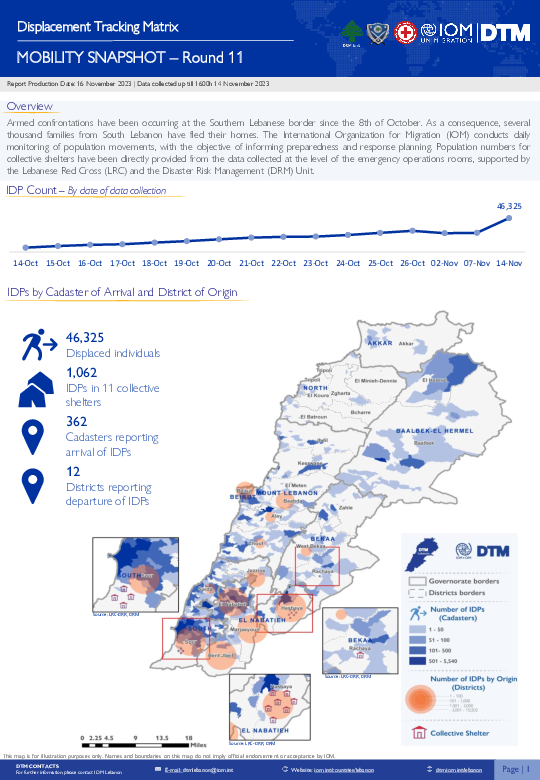
Contact
dtmlebanon@iom.int
Language
English
Location
Lebanon
Period Covered
Oct 10 2023
Nov 14 2023
Activity
- Mobility Tracking
- Baseline Assessment
Since October 8 there has been an increase in cross-border incidents between Israel and Lebanon, resulting in the displacement of people both within the South and elsewhere within the country. Since October 10, the Displacement Tracking Matrix (DTM) has been conducting the daily monitoring of population movements. The objective of the exercise is to inform preparedness and response planning.

Contact
DTMUkraine@iom.int
Language
English
Location
Ukraine
Snapshot Date
Oct 31 2023
Activity
- Baseline Assessment
The Registered IDP Area Baseline Assessment provides granular data on the number and geographic location of officially registered internally displaced people (IDPs) who have displaced since February 2022, as recorded and reported by local authorities across Ukraine. This report assesses registered IDP presence at the raion level, also mapping the recorded change since the previous round. Round 29 presents the data of the recorded registered IDP population disaggregated by sex, age and state-recognised disability status.
The data collected for the Area Baseline Assessment Round 29 reflects the up-to-date local administrative register of the IDP population as of 31 October 2023, equivalent to a total of 3,527,731 registered IDPs recorded. Registered IDP figures were collected for 1,039 hromadas (78% of all hromadas covered in Ukrainian government-controlled areas). Data disaggregated by age, sex and disability status were provided for around 78 per cent of the administrative units covered.

Contact
DTM Europe, DTMMediterranean@iom.int
Language
English
Location
Republic of Moldova
Period Covered
Jul 01 2023
Sep 30 2023
Activity
- Survey
- Return Intention
Since 24 February 2022, refugees from Ukraine and Third Country Nationals (TCNs) have been fleeing to neighbouring countries as a result of the war. IOM has deployed its Displacement Tracking Matrix (DTM) tools since mid-April 2022 to collect individual surveys in neighbouring countries with persons crossing into Ukraine, with the aim to improve the understanding of main profiles, displacement patterns, intentions and needs of those moving into Ukraine.
This report is based on surveys collected in the Republic of Moldova between 01 July 2023 and 30 September 2023 in two border crossing points with Ukraine, Otaci and Palanca.
Key Findings
- Top 3 countries of stay abroad: Republic of Moldova (48%), Romania (11%), Türkiye (7%)
- Top oblasts of origin: Odeska oblast (35%), Kyiv city and Kyivska (22%), Mykolaivska oblast (7%)
- Intended destinations: going to same oblast of origin (92%), to a different oblast (8%) - mainly to Kyiv city, Vinnytska, and Odeska
- Intentions upon crossing back: long-term stay (58%), short-term visit (38%), don't know (4%)
- Top needs upon crossing back:* financial support (22%), medicines and health services (9%), support with personal safety and security (8%)
- Top areas of assistance received:* food products and meals (29%), financial support (28%), NFI/hygiene items (8%), accommodation (7%).
* More than one answer possible
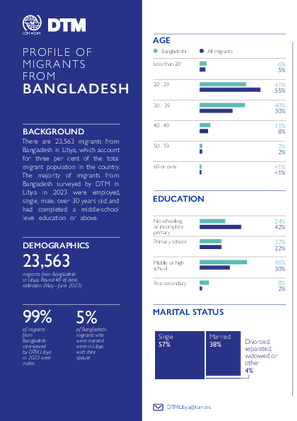
Contact
DTM Libya, DTMLibya@iom.int
Language
English
Location
Libya
Snapshot Date
Jun 30 2023
Activity
- Survey
- Flow Monitoring Survey
- Migrants presence
This document showcases the profiles of migrants from Bangladesh, Burkina Faso, Chad, Egypt, Ghana, Mali, Niger, Nigeria, Sudan and Senegal. The profiles highlight the main sociodemographic characteristics of these migrant populations as well as their labour market conditions, such as their employment status and the main risks they face at work. The data was collected by DTM Libya between January and June 2023.

Contact
DTM Mozambique, DTMMozambique@iom.int
Language
English
Location
Mozambique
Period Covered
May 23 2023
Jul 08 2023
Activity
- Survey
The International Organisation for Migration (IOM) in collaboration with Mozambique’s National Disaster Management Agency (INGD) conducted assessments and stakeholder consultations to monitor progress made towards solutions for displacement-affected communities in Buzi, Caia, Chibabava, Dondo and Nhamatanda districts of Sofala province.
Guided by the International Recommendations for IDP Statistics (IRIS)7 and the Data for Solutions to Internal Displacement Taskforce (DSID,2023), this report aims at informing targeted interventions in key areas of concern and provides initial evidence for programming which can be catalytic to move towards local integration of displaced communities in central Mozambique. By integrating a quantitative and qualitative approach, the report provides an opportunity for the voices of IDPs to be heard focusing mainly on the first five criteria to achieve durable solutions. The goal is to foster a comprehensive grasp of the situation and facilitate collaborative, evidence-based, decision-making regarding further solutions programming.
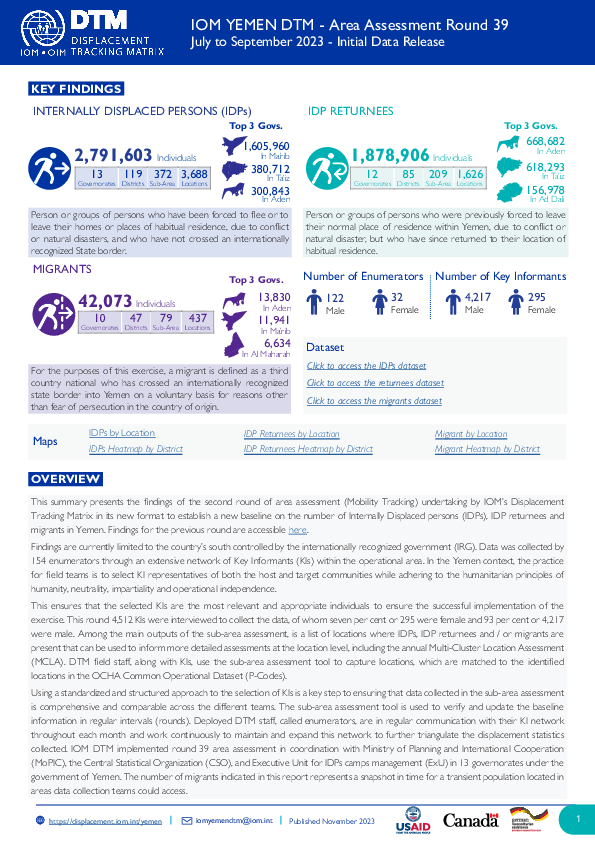
Contact
DTM Yemen, DTMYemen@iom.int
Language
English
Location
Yemen
Period Covered
Jul 29 2023
Sep 20 2023
Activity
- Site Assessment
- Baseline Assessment
This summary presents the findings of round 39 Area Assessment (Mobility Tracking) undertaking by IOM’s Displacement Tracking Matrix in its new format to establish a new baseline on the number of Internally Displaced persons (IDPs), IDP returnees and migrants in Yemen. In round 39 of the Area Assessment carried out between July and September 2023, IOM DTM was able to increase the overall coverage since round 38 conducted in October and November 2022. Consequently, the numbers of recorded IDPs, IDP returnees and migrants as well as accessed locations and districts has equally increased.
Data was collected by 154 enumerators through an extensive network of Key Informants (KIs) within the operational area in coordination with Ministry of Planning and International Cooperation (MoPIC), the Central Statistical Organization (CSO) and Executive Unit for IDPs camps management (ExU) and humanitarian partners in 13 governorates of the government of Yemen.
In the Yemen context, the practice for field teams is to select Key Informant (KI) representatives of both the host and target communities while adhering to the humanitarian principles of humanity, neutrality, impartiality, and operational independence. This ensures that the selected KIs are the most relevant and appropriate individuals to ensure the successful implementation of the exercise.
In this round 39; 4,512 KIs were interviewed to collect the data, of whom seven per cent or 295 were female and 93 per cent or 4,217 were male.

Contact
DTM Peru, IOMDTMPeru@iom.int
Language
English
Location
Peru
Period Covered
Oct 01 2023
Oct 31 2023
Activity
- Flow Monitoring
En el mes de octubre, las regiones fronterizas de Tumbes (norte del Perú) y Tacna (al sur del Perú), han continuado en Estado de Emergencia tras una nueva prórroga de 60 días decretada por el Gobierno peruano, la cual estará vigente hasta el 24 de noviembre del 2023. En la región de Tumbes, el Ministerio del Interior entregó 53 vehículos a los puestos policiales de la provincia de Zarumilla y el despliegue de 1,400 efectivos policiales en toda la región para garantizar la seguridad ciudadana. En la región de Tacna, las fuerzas militares y policiales continúan llevando a cabo tareas de vigilancia para reforzar la seguridad ciudadana y evitar ingresos irregulares a territorio peruano. En la región de Puno, el 12 de octubre se bloqueó el Puente Internacional de Ilave por 24 horas, el cual obstaculizó el tránsito hacia la frontera con Bolivia, vía Desaguadero yYunguyo.
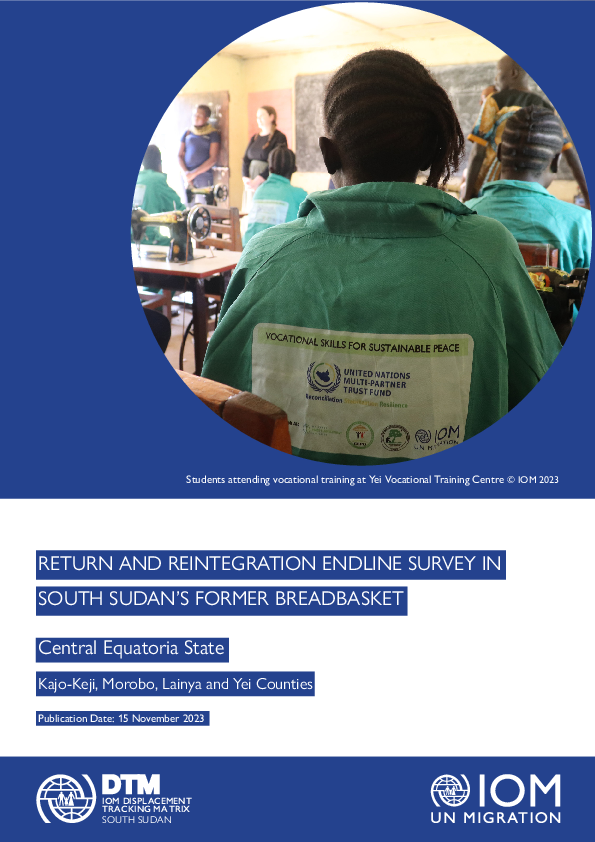
Contact
dtmburundi@iom.int
Language
English
Location
South Sudan
Period Covered
Aug 11 2023
Aug 28 2023
Activity
- Survey
- Return Intention
To gain comprehensive insights into the dimensions of return and reintegration, the International Organization for Migration’s (IOM) Displacement Tracking Matrix (DTM) unit executed a targeted study within Southern Central Equatoria State, as part of the Reconciliation, Stabilization, and Resilience Trust Fund (RSRTF) project in August 2023. This phase of the study involves a meticulous difference analysis between the baseline and endline, designed to illuminate the shifts in the region’s circumstances and provide clarity regarding its current trajectory. By drawing comparisons between these surveys, the intention is to furnish stakeholders with actionable insights that can inform future humanitarian and developmental strategies, ensuring their relevance and effectiveness.
The findings obtained through the survey serve the purpose of establishing an endline and pinpointing the gaps and barriers that impact reintegration and stabilization efforts in Southern Central Equatoria State. This report presents a comprehensive analysis based on data that is representative of the county level. It is crucial to interpret the findings with an understanding of this scope. While the collected data provides valuable insights into the conditions and trends within the counties, its representation of smaller, sub-county divisions is more indicative in nature. In essence, while the report captures broader county-level trends, it may not precisely detail every nuance or variation present at sub-county levels.
Return and Reintegration Index
The Return and Reintegration Index combines data (the numerical version of the data) from eight indicators (8 key areas: housing, livelihoods, WASH, health, education, social cohesion, community stability, and protection) into a single number that provides an indication of the favourability of conditions (Stability Index) to the return and reintegration of displaced people. The calculation of the index was done at the household level.
The index score ranges from 0 to 10 where the higher the index the more favourable the conditions are for the return and reintegration of IDPs and refugees.
The calculation of the index was done at the household level and the results were aggregated at all administrative levels and by population type.
The average (mean) index score is 5.56 out of 10 with both the mean and median values indicating that the central tendency of the data is between 5 and 6.
Kajo-Keji and Morobo emerge as the two best-performing counties, as determined by the average (mean) index scores. While ‘Returnees’ and ‘IDPs’ report the highest mean index scores at 5.79 and 5.72 respectively, it’s important to note that the deviation among the different population groups is minimal, with all scores ranging between 5.3 and 5.7. This indicates a relatively uniform experience across the board, suggesting that while some groups are slightly better off, no single group is significantly outperforming or lagging the others in terms of the index score. Returnees and IDPs appear to experience relatively favorable conditions for return and reintegration compared to those who have been relocated.
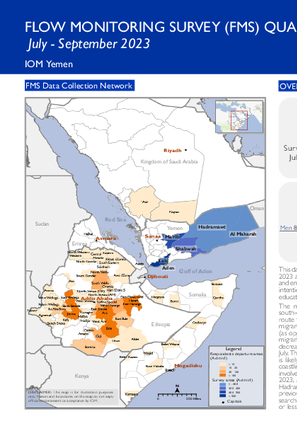
Contact
DTM Yemen, DTMYemen@iom.int
Language
English
Location
Yemen
Period Covered
Jul 01 2023
Sep 30 2023
Activity
- Flow Monitoring Survey
- Flow Monitoring
This dashboard compiles flow monitoring survey (FMS) data collected in Yemen between July and September 2023 and provides an analysis of migrants’ demographic and socio-economic profiles, including education and employment backgrounds, reasons for leaving their country of origin or habitual residence, future travel intentions, protection and challenges faced during the journey. Also included are migrants’ highest level of education achieved and their labour status prior to moving.
The migration routes in the southern part of Yemen are categorized along two main routes: the south-east route towards Shabwah, Hadramawt, and Al Maharah governorates and the north-east route towards Lahj and Ta’iz governorates. Both routes are traditionally travelled by a large number of migrants each year. Through the Flow Monitoring Registry tool, which focuses on total numbers of migrants (as opposed to the more detailed migrant profile established through the FMS).
DTM recorded 15,227 migrants entered Yemen through the south in the third quarter of 2023. This figure represents a significant decrease compared to the previous quarter, with nearly two thirds (62%) of all migrants were recorded in July. The remainder was recorded in August and September. The significant decrease observed since August is likely attributed to the ongoing joint military campaign initiated to combat smuggling and secure the coastline of Lahj, a well-known governorate for receiving the largest proportion of migrants. The campaign involved deploying troops, conducting raids, and establishing checkpoints.
During the third quarter of 2023, a total of 2,705 surveys were conducted. In Aden (667), Lahj (655), Ma’rib (487), Shabwah (409), Hadramawt (245) and Al Maharah (242). The overall number of surveys increased by one per cent over the previous quarter. The majority of respondents were young male adults between the age of 17 and 25 (78%) searching for economic opportunities (95%), most of whom were single (92%), attained primary education or less (60%), were currently unemployed (94%) and departed from rural areas (78%).
Pagination
- Previous page
- Page 64
- Next page
